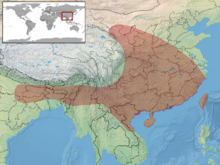pms
nòm ant ël fil


The genus Protobothrops was described to accommodate two species previously placed in the genus Trimeresurus, T. jerdonii and T. mucrosquamatus. In their 2007 revision, Guo et al. placed 10 species in this genus, including P. mucrosquamatus.
The dangerously venomous Protobothrops mucrosquamatus is known from Myanmar (Kachin State), northeastern India and Bangladesh, China, Taiwan, and northern Vietnam. It is found n the Northern Triangle temperate and subtropical forests of Kachin State (Myanmar) at elevations of 250-1088 m. Individuals have been found near streams either under rocks or in the leaf litter. Historically, this species has been reported to be common in hilly and mountainous areas. More recently, the species has been described as common in Vietnam around villages and disturbed habitats. These snakes are active at night. (Leviton et al. 2003 and references therein)
Leviton et al. (2003) provide a technical description of this species: Scales in 25 longitudinal rows at midbody. Scales on upper surface of head small, each keeled posteriorly. Internasals 5-10 times size of adjacent scales, separated by 3-4 scales. Supraoculars long, narrow, undivided, 14-16 small interocular scales in line between them. 2 scales on line between upper preocular and nasal; 9-11 upper labials, first upper labial separated from nasal by suture; 2-3 small scales between upper labials and subocular; 2-3 rows of temporal scales above upper labials smooth, above those scales keeled; ventrals 200-218; subcaudals 76-91, all paired; grayish or olive brown above, with dorsal series of large brown, black-edged spots or blotches, and a lateral series of smaller spots; head above brownish, below whitish; belly whitish but heavily powdered with light brown; tail brownish (possibly pink in life) with series of dark dorsal spots. Hemipenes spinose. Total length: males: 1122 mm, females 1160 mm; tail length: males 195 mm, females 205 mm.
Guo and Zhao (2006) undertook an analysis of skull morphology of nine Asian pit vipers, including Protobothrops mucrosquamatus.
Zhang et al. (2013) sequenced the complete mitochondrial genome of P. mucrosquamatus.
Chen et al. (2007) discussed treatment in Taiwan of bites by P. mucrosquamatus and Trimeresurus stejnegeri, which together account for the majority of snakebites in northern Taiwan
Protobothrops mucrosquamatus is a venomous pit viper species endemic to Asia. Common names include: brown-spotted pit viper,[4] Taiwanese habu and pointed-scaled pit viper.[5] No subspecies are currently recognized.[6] The species was first described by Theodore Cantor in 1839.[7]
Males grow to a maximum total length of 112 cm (44 in) with a tail length of 19.5 cm (7.7 in). Females grow to a maximum total length of 116 cm (46 in) with a tail length of 20.5 cm (8.1 in).[8]
Scalation: dorsal scales in 25 longitudinal rows at midbody; scales on upper surface of head, small, each scale keeled posteriorly; internasals 5–10 times size of adjacent scales, separated by 3–4 scales; supraoculars, long, narrow, undivided, 14–16 small interoculars in line between them; 2 scales on line between upper preocular and nasal scale; 9–11 upper labials, first upper labial separated from nasal by suture; 2–3 small scales between upper labials and subocular; 2–3 rows of temporal scales above upper labials smooth, above those scales keeled; ventrals 200–218; subcaudals 76–91, all paired.[8]
Color pattern: grayish or olive brown above, with dorsal series of large brown, black-edged spots or blotches, and a lateral series of smaller spots; head above brownish, below whitish; belly whitish but heavily powdered with light brown; tail brownish (possibly pink in life [fide M.A. Smith 1943:507]), with series of dark dorsal spots.[8]
Brown spotted pitviper,[4] pointed-scaled pit viper, habu,[5] Taiwan habu (タイワンハブ), Chinese habu, Formosan pit viper.[9] The Chinese name is 龜殼花蛇 or 原矛头蝮.
Found from northeastern India (Assam and Mizoram) and Bangladesh, to Myanmar, China (including Hainan, and as far north as Gansu and as far east as Zhejiang), Laos, northern and central Vietnam, also found in northern Thailand as well as in Taiwan. The type locality given is Naga Hills (India).[2][3] This snake is introduced to Okinawa, Japan.
Protobothrops mucrosquamatus is a venomous pit viper species endemic to Asia. Common names include: brown-spotted pit viper, Taiwanese habu and pointed-scaled pit viper. No subspecies are currently recognized. The species was first described by Theodore Cantor in 1839.
Protobothrops mucrosquamatus Protobothrops generoko animalia da. Narrastien barruko Viperidae familian sailkatuta dago.
Protobothrops mucrosquamatus Protobothrops generoko animalia da. Narrastien barruko Viperidae familian sailkatuta dago.
Habu de Taïwan, Vipère à taches brunes, Vipère à écailles pointues
Protobothrops mucrosquamatus (Habu de Taïwan, Vipère à taches brunes, Vipère à écailles pointues) est une espèce de serpents, de la famille des Vipéridés[1].
Cette espèce se rencontre[1] :
C'est un serpent venimeux. Il atteint un peu plus d'un mètre pour les mâles, les femelles étant un peu plus grandes. Il est gris ou vert-brun avec de larges points ou taches brun bordé de noir sur le dos et de petits points sur les côtés. La tête est brune, le dessous du corps est clair.
Habu de Taïwan, Vipère à taches brunes, Vipère à écailles pointues
Protobothrops mucrosquamatus (Habu de Taïwan, Vipère à taches brunes, Vipère à écailles pointues) est une espèce de serpents, de la famille des Vipéridés.
Trimeresurus mucrosquamatus là một loài rắn trong họ Rắn lục. Loài này được Cantor mô tả khoa học đầu tiên năm 1839.[4]
Trimeresurus mucrosquamatus là một loài rắn trong họ Rắn lục. Loài này được Cantor mô tả khoa học đầu tiên năm 1839.

龜殼花,又名原矛头蝮(学名:Protobothrops mucrosquamatus)为蝰科原矛头蝮属的爬行动物,俗名烙铁头、笋壳班等、老鼠蛇和恶乌子等,是台灣六大毒蛇之一。
龜殼花常與無毒的擬龜殼花混淆,不過擬龜殼花的頭部較圓。
龜殼花分布於印度、孟加拉、緬甸、沖繩、台灣以及中國大陸的浙江、安徽、福建、江西、湖南、廣東、廣西、海南、四川、重慶、貴州、雲南、陝西、甘肅等地。
龜殼花常栖息于丘陵及山区、栖于竹林、灌丛、溪边、茶山、耕地以及常到住宅周围如草丛、垃圾堆、柴草石缝和落葉堆裡。其生存的海拔范围为82至2200米。该物种的模式产地在印度阿萨姆。平時與人接觸時通常會選擇離開,除非被侵擾否則不會馬上對人發動攻擊,雌蛇有護卵行為,在護卵期間若遭干擾則會主動採取攻擊。[2]
龜殼花,又名原矛头蝮(学名:Protobothrops mucrosquamatus)为蝰科原矛头蝮属的爬行动物,俗名烙铁头、笋壳班等、老鼠蛇和恶乌子等,是台灣六大毒蛇之一。
龜殼花常與無毒的擬龜殼花混淆,不過擬龜殼花的頭部較圓。

タイワンハブ(台湾波布、台湾飯匙倩、Protobothrops mucrosquamatus)は、爬虫綱有鱗目ヘビ亜目クサリヘビ科ハブ属に分類されるヘビ。有毒。
台湾および中国南部、インドシナ半島北部に生息する。また、人によって持ち込まれた個体が、沖縄本島にも分布を広げている。
全長は80-130cm。[1]ハブに比べると小型で、やや白っぽい灰褐色に黒い模様が規則正しく並んでおり、サキシマハブによく似るが、体型は細く、その点ではハブに似る。[1]
頭は細長い三角形。
本種の毒は強く、ハブよりも強いといわれる。顔が細長く、通常のハブ類よりも長い牙を収納できるため、牙が長い。そのため、身体のより深部に毒を打ち込むことができるので、噛まれたときの症状は深刻である。 ただし、毒の量はあまり多くないため、死者は稀である。性質もハブほど攻撃的ではない。[1]
基本的にハブやサキシマハブに似る。[1]
平地から山地の森林、草原、水辺、農地に住む。樹上性で、地表に降りることもあるが、原産地ではヒャッポダなどの他のクサリヘビ類も多いため、他のハブに比べて樹上での活動が多い。夜行性。
食性は動物食でネズミ等の小型哺乳類・小鳥などの鳥類・トカゲ・カエルを食べる。
元々はマングースとの決闘ショーやハブ酒用のハブの代用品として、日本国内に輸入されていた。1990年代に、名護市で初めて帰化個体が発見されて以来、周辺地域への分布域拡大が確認されている。これは、外国産の毒蛇(外来種)が初めて日本国内に帰化・定着した例である。また、その個体数も年々増加傾向にあり、実際に本種に噛まれる事故も発生している。 この沖縄本島への帰化・定着により、以下の幾つかの問題が懸念されている。
ちなみに、交雑個体及び本種の毒に対しては既存のハブ抗毒素が効くことが確認されており、もし咬まれても治療には特に問題はないと考えられている。ただ、ハブとの雑種に噛まれた場合、より多くの血清が必要となる。[1]
今後さらに分布域が拡大すれば咬傷被害が増えることが懸念される。沖縄本島では、一刻も早い駆除が望まれている。